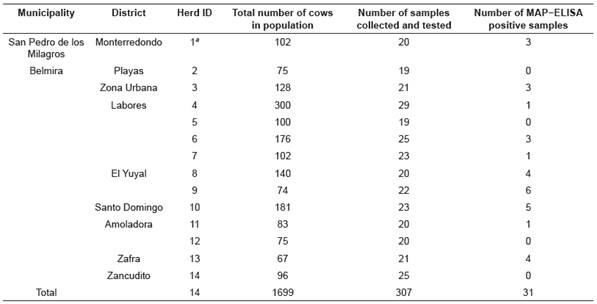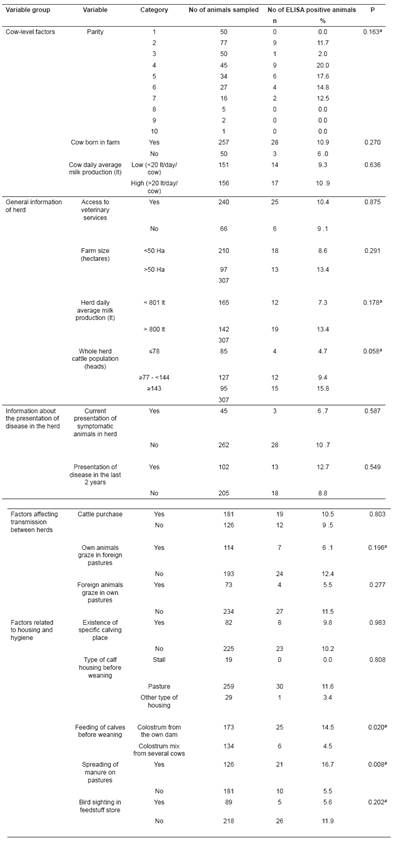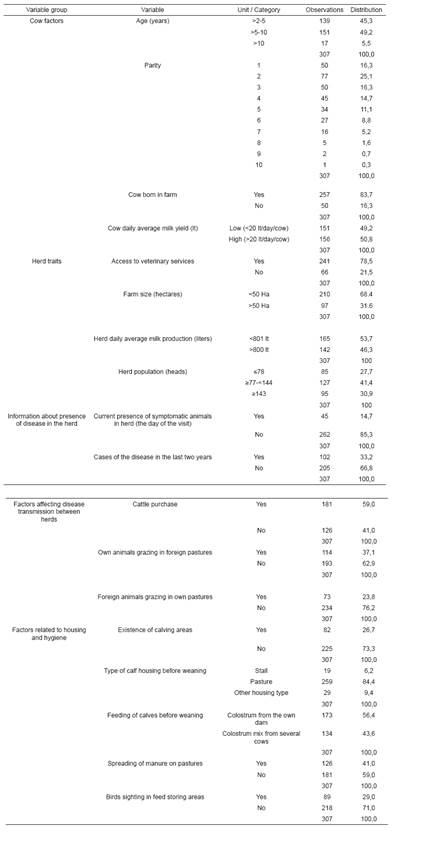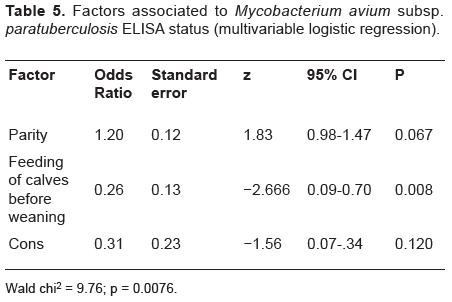Introduction
Johne´s disease (JD) or paratuberculosis is a severe enteritis that affects cattle and other domestic and wild ruminants (Harris and Barletta, 2001). The causal agent of JD is Mycobacterium avium subspecies paratuberculosis (MAP), a Gram-positive, facultative, mycobactin-dependant, slow growing, and acid-fast bacillus (Chiodini et al., 1984; Sweeney, 1996). MAP has also been associated with the human inflammatory bowel disease known as Crohn’s disease (Chacon et al., 2004; Atreya et al., 2014; Sechi and Dow, 2015).
Johne´s disease causes substantial economic losses to the cattle industry due to increased premature culling, replacement costs, decreased milk yield, reduced feed conversion efficiency, fertility problems, reduced slaughter values, and increased susceptibility to other diseases or conditions (Johnson et al., 2001; Kudahl et al., 2004; Weber, 2006; Beaudeau et al., 2007; Gonda et al., 2007; Nielsen and Toft, 2009; Richardson and More, 2009; McAloon et al., 2016). It is known that this disease has a global distribution (Barkema et al., 2010; Manning and Collins, 2010).
Prevention and control of JD demands knowledge on the disease presence, frequency, and distribution as well as those factors influencing its entrance and perpetuation in herds. Herd management practices can increase or decrease the probability of MAP entering or circulating in a dairy cattle population. These practices vary, not only between countries or agro ecological zones, but also between regions and herds, thus requiring to determine specific factors associated with JD status of animals or herds in each region.
Previous studies have identified a number of cow and herd management factors that can influence MAP status. Most of these studies have been conducted using the herd as the unit of analysis, and have used serological results to establish the MAP diagnosis of animals, as well as the subsequent identification of risk factors (Collins et al., 1994; Goodger et al., 1996; Johnson-Ifearulundu and Kaneene, 1999; Jakobsen et al., 2000; Hacker et al., 2004; Dieguez et al., 2008; Nielsen et al, 2008; Tiwari et al., 2009; Sorge et al., 2012; Pieper et al., 2015; Vilar et al., 2015). However, other diagnostic methods, such as PCR (Ansari-Lari et al., 2009), fecal culture (Obasanjo et al., 1997), and mixed methods (Kobayashi et al., 2007) have been used to establish JD prevalence and risk factors.
A previous study reported MAP seroprevalence of 3.6% (14/696) and 2% (1/28) at the herd and animal-level, respectively. In addition, days in milk between 100-200 days (OR = 4.42) and >200 days (OR = 3.45), and the daily milk yield between 20-40 L/cow (OR = 2.53) and >40 L/cow (OR = 20.38) were identified as risk factors for MAP seropositivity (Correa-Valencia et al., 2016).
The objective of this study was to identify cow and herd management factors associated with the serological individual status to MAP (based on ELISA -enzyme-linked immunosorbent assay- results) in 307 asymptomatic lactating Holstein cows from 14 herds in San Pedro de los Milagros, Antioquia (Colombia).
Materials and methods
Ethical considerations
The study was conducted following the Statute of Good Scientific Practices of the Justus-Liebig-University Giessen (Statute of Justus Liebig University Giessen for Ensuring Good Academic Practice, 29th May 2002).
Herds and animals
In November 2007, 14 herds located in nine districts of two municipalities (Belmira and San Pedro de los Milagros) in the Northern dairy region of Antioquia province, Colombia, were sampled for detecting anti-MAP antibodies. Blood samples were collected from 307 asymptomatic Holstein cows over two years of age. One of the herds presented sporadic clinical cases compatible with JD, which was confirmed by PCR and histopathology (Zapata et al., 2010; Ramírez et al., 2011). The animals tested in every herd were randomly selected (Table 1).
Table 1 Results of Mycobacterium avium subsp. paratuberculosis ELISA of dairy cows in 14 dairy herds located in 9 district of two municipalities in Northern Antioquia, Colombia.

a Herd with history of JD (Zapata et al., 2010). b Corresponds to a representative sample of animals ≥ 2 years of age
Enzyme-linked immunosorbent assay (ELISA)
The indirect unabsorbed ELISA, based on the detection of MAP−lipoarabinomannan (LAM, Svanovir Para−TB Ab ELISA Kit®, Svanova Biotech AB, Uppsala, Sweden) was used to detect anti-MAP antibodies. Percent positivity (PP) by ELISA considered the optical density values (OD) obtained at 450 nm, using the following formula:
PP = mean OD value (sample or negative control) / mean OD value (positive control) x 100.
An ELISA-positive case was defined as an animal with a PP ≥ 53 and a negative case as an animal with a PP ≤ 31. Eight out of 307 (2%) doubtful results (PP >31 - < 53) were considered negative. Regarding the factors associated with MAP status, a positive or negative ELISA result was considered the outcome or dependent variable.
Factors associated with MAP serologic status
Information regarding cow and herd management practices was collected to determine factors that could be associated with the cow serological status. Cow factors and herd management practices have been associated with JD status in previous studies using the same diagnostic test (ELISA). Two questionnaires were administered to herd managers and/or owners during sample collection. The first questionnaire asked for information regarding cow factors such as identification (number and name), age, farm-born, parity, and daily milk yield. The second questionnaire asked for information regarding herd management practices related to maintenance or transmission of MAP within and between herds. Questions related to herd management practices were distributed into four groups; Group 1: general information of the herd (farm size, access to veterinary services, daily milk production, and cattle population); Group 2: information regarding presence of the disease in the herd (current presentation of symptomatic animals, and cases of Johne’s disease observed during the last two years); Group 3: management factors affecting MAP transmission between herds (cattle purchase, own animals grazing on foreign pastures, foreign animals grazing on own pastures); and Group 4: factors regarding housing and hygiene (existence of a calving area, type of calf housing before weaning, feeding of calves before weaning, spreading of manure on pastures, and bird sighting in feed storing areas, Table 2).
Case definition
The case definition for a MAP-infected animal was a cow with an ELISA seropositive result (PP ≥ 53).
Statistical analysis
The data collected during the study (Table 2) was saved in Excel (Microsoft Corp., Redmond, WA, USA) and then exported to Stata 12.0 (StataCorp, 2011, Texas, USA) for statistical analysis. The data was examined for biologically implausible entries. Erroneous data were removed or corrected. Descriptive statistics were computed for all variables (Table 3 and 4). An initial exploratory analysis of the data was conducted using Chi−square and Fisher’s exact tests. Results of the initial exploratory analysis revealed that “parity”, “herd population (heads)”, “own animals grazing in foreign pastures”, “feeding of calves before weaning”, and “spread on pastures” were significantly associated with cow serological status (data not shown). Subsequently, Pearson and Spearman correlation analysis was executed for continuous and categorical variables, respectively. An unconditional mixed−effects logistic regression analysis, grouped by herd to account for clustering, was performed. The criteria of Hosmer-Lemeshow (p<0.25) was used to retain variables for the multivariable model. A multivariable mixed−effects logistic regression model, grouped by herd, was performed using a significance level of p<0.05. The results from the final model are presented as odds ratios (OR) with 95% confidence intervals (CIs). The response variable was the serum status ELISA for MAP (positive or negative). The cluster effect was random and all risk factors (parity, own animals grazing in foreign pastures, feeding of calves before weaning, spreading of manure on pastures, birds sighting in feed storing areas) were fixed effects. The logistic model took the general form: (Y) ~ binary outcome (probability π), Logit (π) = ß0 intercept + ß1 Parityij + ß2 average daily milk production of the herd (lt) + ß3 herd population (heads) + ß4 own animals grazing in foreign pasturesj + ß5 feeding of calves before weaningj + ß6 spreading of manure on pasturesj + ß7 birds sighting in feed storing areas + eij Where Yij= outcome variable at i-th cow and the jth farm π = fitted probability of the outcome, ß1 to ß5 = coefficients associated with each covariate, eij = random residual effect.
Results
ELISA
Ten percent (10.1%, 31/307; 95% CI: 6.7-13.5%), and 89.9% (276/307; 95% CI: 86.5-93.3%) of the samples produced positive and negative results by ELISA, respectively. In 70% (10/14) of the herds, ELISA detected at least one seropositive animal (Table 1).
Factors associated with MAP serologic status
Analysis of correlation revealed collinearity (>0.80) between the variable “age” (years) and “parity” according to previous concepts (Dohoo et al., 2010); therefore, the former was excluded from the analysis. The results of the univariable analysis revealed that the factors “parity”, “herd daily average milk production (liters)”, “whole cattle population”, “own animals grazing in foreign pastures”, “feeding of calves before weaning”, “manure spread on pastures”, and “birds sighted in feedstuff store” were significantly associated with cow serological status (p<0.25; Table 4). These variables were selected for the multivariable analysis. In the final logistic regression model, the factors identified were as follows: “parity” (OR = 1.20), and “feeding of calves before weaning” (OR = 0.26; Table 5).
Table 3 Descriptive summary of quantitative variables in dairy cows of the Northern dairy region of Antioquia, Colombia, according to Mycobacterium avium subsp. paratuberculosis ELISA results.

aVariable excluded from the unconditional analysis due to collinearity (>0.80).
Table 4 Unconditional analysis of factors associated with the Mycobacterium avium subsp. paratuberculosis ELISA status in 307 dairy cows of Northern Antioquia, Colombia.

aVariables used for the multivariable analysis (p<0.25).
Discussion
The proportion of ELISA positive results obtained from animals (10.1%) and herds (70%) is consistent with the apparent prevalence of JD in other Latin-American countries, using both unabsorbed and absorbed ELISAs (Fernandez-Silva et al., 2014).
The factors “feeding of calves before weaning” and “parity” were significantly associated with the ELISA status of the cow in the initial exploratory analysis, in both the bivariable and multivariable analysis. Mycobacterium avium subspecies paratuberculosis (MAP) has been isolated from colostrum of subclinically infected cows (Streeter et al., 1995; Pithua et al., 2011; Stabel et al., 2014; Laurin et al., 2015; Jenvey et al., 2016). Additionally, the practice of feeding calves with colostrum collected from known MAP infected cows (Dieguez et al., 2008), as well as the practice of feeding calves pooled colostrum from multiple cows (Nielsen et al., 2008) have been identified as risk factors for MAP in dairy herds. Therefore, our results indicating a protective factor (OR = 0.26) disagree with this previous evidence and should be interpreted carefully. It is also possible that MAP contaminated teats can increase the likelihood of infection via suckling directly from an infected dam, compared to feeding from a colostrum mix of MAP free cows (Pithua et al., 2011). In our study, information regarding the method of colostrum feeding was not collected; therefore, this hypothesis cannot be confirmed. “Parity” was associated with JD serological status in previous studies, in which high parity (≥ 5) was associated with the probability of a positive ELISA result (Jakobsen et al., 2000). Additionally, the probability of a positive ELISA result was two to three times lower for first parity cows relative to cows in other parities (Nielsen et al., 2002).
Factors “born in a foreign herd” (Wells and Wagner, 2000; Tiwari et al., 2009; Sorge et al., 2012), “comingle with foreign cattle” (Fredriksen et al., 2004) and “manure spread on pastures” (Obasanjo et al., 1997), have previously been associated with JD status of herds. However, the present study found no significant associations in the multivariable analysis in relation to the herd ELISA status. This could be explained by the fact that our study was smaller concerning sample size in terms of number of herds. With our small sample size and our cow-based analysis, it is possible that significant associations, although present, could not be detected. In order to achieve a higher power, bigger sample sizes should be used. Unfortunately, a bigger sample size was not affordable at the time of the present exploratory study.
In Colombian dairy production systems, the purchase and exchange of animals between herds is relatively common. Animals regularly purchased for replacement or for fattening, are kept in the herd of origin until weaning and then transported to their final destination. This practice increases the risk of JD transmission to free herds due to introduction of young, subclinically infected, animals (Manning and Collins, 2010). Similar to what was found in the present study, spreading manure on pastures has been reported as a factor associated with the MAP culture results in the univariate, but not in the multiple logistic regression analysis in a previous study in the United States (Obasanjo et al., 1997). In Colombia, it is common practice to spread slurry (cattle feces alone or in combination with pig feces) as manure for pasture. This type of mix has already been identified as a potential source of MAP for cattle, considering its survival capacity for long periods (up to 252 days at 5 °C) in cattle, pig, and cattle-pig slurry (Jorgensen et al., 1977). MAP can withstand simulated composting, manure packing and liquid storage of manure from dairy farms (Grewal et al., 2006).
The low number of cattle and herds sampled is the main weakness of this study, but it can significantly contribute to the knowledge of JD in the country. Another disadvantage is the use of ELISA results as the outcome or dependent variable. ELISA is a very useful and economic tool to determine JD infection status of animals but it has low sensitivity to detect antibodies in asymptomatic adult cattle (Nielsen and Toft, 2011). However, ELISA has been widely used for prevalence and risk factor determinations, it is inexpensive, easy to perform, and results can be compared with previous national and international studies.
Conclusion
“Parity” was a risk factor for MAP status while “feeding of calves before weaning” appeared to be protective for the serological status to MAP in the herds tested. Additional studies are necessary to increase epidemiological knowledge of JD in Colombia.
Acknowledgments
Thanks to ALECOL academic cooperation agreement (German Academic Exchange Service−DAAD, Universidad de Antioquia and Colciencias-Ministerio de Educación Nacional), Departamento de Formación Académica de Haciendas de la Facultad de Ciencias Agrarias UdeA, Michale Bülte, Amir Abdulmawjood, Ömer Akineden, Estrategia de sostenibilidad CODI 2013-2014 UdeA, and Michael Palacio, Ferney Agudelo, and Julian Reyes for logistic support at the UdeA, Colombia.
















